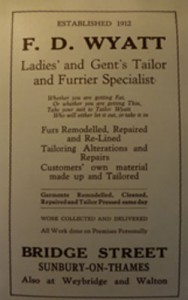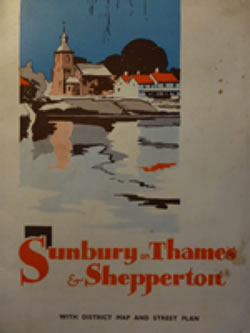“Sunbury on Thames is primarily a residential resort of a quiet and reposeful type. It would indeed be difficult to find a more ideal spot in which to settle.”
This would be a perfect description of Sunbury today, yet it was written at the end of the 1930’s.
With the arrival of the railway and the spreading of the London Metropolis, people started to look outside the ‘smoke’ for an alternative place to live. Sunbury and Shepperton were on the map. Houses were being built and there was a big marketing push to sell the idyll of village life.
The Burrows Official Guide to Sunbury on Thames and Shepperton (see above) informs would be residents about the attractions of the area probably on behalf of local government/council. Burrows have been producing such guides since 1901. (What is interesting to me is that they are the same size as Sunbury Matters and are full of advertising!)
To look back at a document about our village from times gone by you learn so much. Not many homes had telephones so telephone numbers were only 2 digits. Readers are told about the modern facilities available in the village listing transport, gas and electricity and then adding “an abundant supply of pure water”. (We can certainly testify that water is abundant after last year’s experience!)
At the time (and for several decades after) there was an open air pool, which many of you will remember. The guide talks about the pool being “complete with diving boards and up to date dressing rooms, the water being obtained from the river Thames and renewed at frequent intervals”. Really? River water? Needless to say it was not heated and if you ask anyone who remembers using it, the overwhelming memory is of how cold the water was.
A first class return to Waterloo would have set you back 5/6 which is 27 1/2p in new money. Imagine that! 3rd class (there was no second class then) was only 3/4 or just over 15p.
There was plenty of shopping in Sunbury: butchers, hardware stores, gentlemen’s clothing, a tailor and furriers and a dairyman (see above). The advert for F D Wyatt, the tailor, made me laugh with his little verse:

“Whether you are getting fat
Or whether you are getting thin
Take your suit to Tailor Wyatt
Who will either let it out, or take it in”.
Some things in life never change!
Thames Street was indeed a thriving high street. We may have lost a lot of the shops, but it is good to see some familiar places.
Sunbury was also home to various industries: the Sundeala Building Boards, the Sunbury Motor Glass Works and of course Wilson’s Boat Builders, which still, for now, has a presence in the village.
Hotels and pubs were plentiful. The Magpie used to offer B&B from 7/6 (37 1/2p) and you could get lunch for 2/- or 10p!
But what of the Sunbury Lodge Hotel, or Blakesley Lodge, both privately run guest houses.
A document such as this Burrows guide keeps our heritage alive. As we walk down Thames Street and enjoy the river views by Kings Lawn think of these words selling Sunbury as a wonderful place to live:
“The town appeals to the lover of the beautiful in nature and art. Viewed from the river, the town with its fine old red-brick houses and red tiled roofs toned into mellowharmony with the majestic elms and cedars amongst which they are deeply set, presents a picture of old world lure and charm that could not easily be surpassed.”
I wonder if at the end of the 21st century someone may look at a copy of Sunbury Matters and wonder at the way the village used to be, the businesses and the people who lived here. You never know!
Thanks to Ted Hiscock for sharing these documents. If you have a story to tell, or something of interest to share please do get in touch with us:info@villagematters.co.uk

